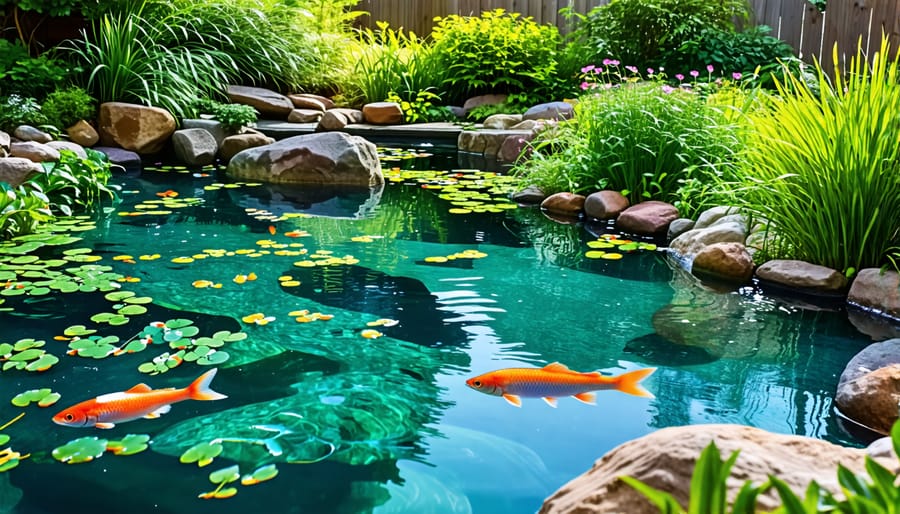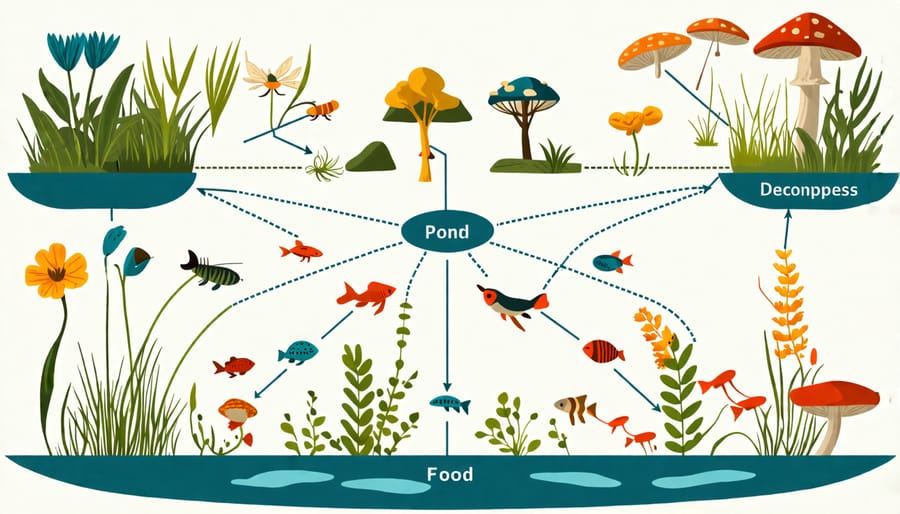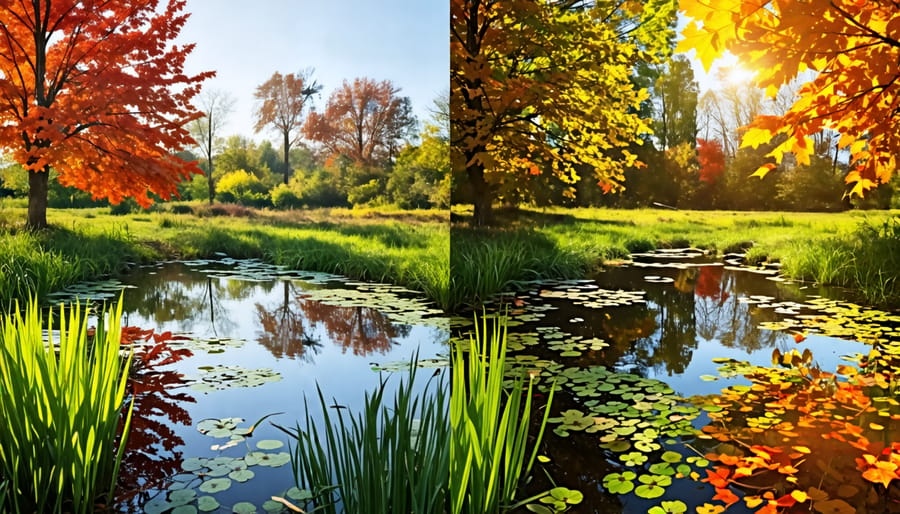
Dive into the Wonders of Your Backyard Pond Ecosystem
Dive into the captivating world of a pond ecosystem – a complex, interconnected web of life teeming just beneath the surface. From the tiniest microbes to majestic fish and aquatic plants, each element plays a vital role in maintaining the delicate balance of this aquatic microcosm. Join us as we explore the intricate cycles and relationships that breathe life into these backyard oases, and discover how you can cultivate your own thriving pond paradise. Get ready to immerse yourself in the wonders of nature, right in your own backyard!
The Pond’s Living Landscape

The Importance of Water Quality
Water quality is vital for maintaining a healthy pond ecosystem. The pH level indicates how acidic or alkaline the water is, with most aquatic life thriving in a neutral range of 6.5 to 8.5. Regularly testing and adjusting pH ensures optimal conditions for plants, fish, and beneficial bacteria. Oxygen levels are another crucial factor, as aquatic organisms need dissolved oxygen to survive. Installing a fountain, waterfall, or aerator helps circulate and oxygenate the water. Water clarity is not only aesthetically pleasing but also essential for pond health. Clear water allows sunlight to penetrate, supporting photosynthesis in submerged plants. It also makes it easier to spot and address any issues like algae blooms or sick fish. Maintain clarity by using beneficial bacteria, proper filtration, and regular cleaning. Keeping an eye on these key water quality parameters and taking prompt action when needed will help you create a balanced, thriving pond ecosystem that brings joy and beauty to your outdoor space.
Plants: The Pond’s Natural Filters
Aquatic plants are the unsung heroes of pond ecosystems, working tirelessly to maintain clean, healthy water. These botanical wonders act as natural filters, absorbing excess nutrients and pollutants that can harm fish and other pond inhabitants. Aquatic plants also release oxygen into the water through photosynthesis, ensuring a well-oxygenated environment for all pond residents.
Submerged plants like hornwort and anacharis are particularly effective at oxygenating the water, while floating plants such as water lettuce and water hyacinth shade the pond and keep algae growth in check. Marginal plants, including cattails and rushes, stabilize the pond edges and filter runoff before it enters the water.
By incorporating a diverse array of aquatic plants into your pond, you create a self-sustaining ecosystem that maintains water clarity and supports a thriving community of fish, insects, and other organisms. As a bonus, these plants add visual interest and beauty to your pond, making it a stunning focal point in your outdoor space. Embrace the power of aquatic plants and watch your pond come to life!

The Pond Food Web
Producers: Algae and Aquatic Plants
Algae and aquatic plants form the foundation of a pond ecosystem, harnessing the sun’s energy to fuel the entire food web. Through photosynthesis, these primary producers convert sunlight, water, and carbon dioxide into oxygen and organic compounds. Algae, including phytoplankton, grow suspended in the water column, while aquatic plants take root in the pond sediment.
Aquatic plants come in various forms, such as submerged plants like hornwort and waterweed, floating plants like water lilies and duckweed, and emergent plants like cattails and rushes. Together, they provide food, shelter, and spawning grounds for pond inhabitants. They also help maintain water clarity by absorbing excess nutrients that could otherwise lead to algal blooms.
The oxygen produced by algae and plants during photosynthesis is vital for fish and other aquatic life. In turn, the carbon dioxide released by respiring organisms is used by the producers, creating a balanced cycle. By kickstarting the flow of energy and nutrients, algae and aquatic plants play a crucial role in sustaining the delicate balance of a thriving pond ecosystem.
Consumers: Fish, Snails, Insects and More
Beneath the tranquil surface of a pond, a bustling world of diverse creatures thrives. Fish, the most iconic pond inhabitants, come in various species adapted to freshwater environments. Goldfish, koi, and native fish species swim gracefully through the water, feeding on algae, insects, and plant matter. Snails, another crucial component of the pond life, help maintain balance by consuming algae and decaying vegetation. Their slow, methodical movements along the pond floor and surfaces contribute to the ecosystem’s cleanliness.
Insects, both aquatic and terrestrial, play vital roles in the pond’s food web. Water striders, backswimmers, and diving beetles skim along the surface or swim underwater, hunting smaller insects and larvae. Dragonflies and damselflies, with their vibrant colors and acrobatic flights, also feed on insects, while their larvae, known as nymphs, live underwater and prey on small aquatic organisms. Amphibians, such as frogs and newts, find shelter in the pond’s shallow areas and feast on insects, making them an essential link in the ecosystem’s energy transfer. Together, these diverse consumers help maintain the delicate balance of pond life, each playing a unique role in the complex web of relationships within the ecosystem.
Decomposers: The Pond’s Recycling Crew
Decomposers like bacteria, fungi, and scavengers such as snails and worms play a crucial role in the pond ecosystem by breaking down dead plant material, fish waste, and other organic matter. This process releases nutrients back into the water, which algae and plants then absorb. Bacteria colonize on surfaces and in the substrate, while fungi attack decaying vegetation. Scavengers feed on debris and help shred it into smaller bits for microbes to digest more easily. Without decomposers, waste would accumulate, leading to toxic conditions. These tiny recyclers work tirelessly to keep the pond clean and balanced, supporting the entire web of aquatic life.
Seasonal Changes in the Pond Ecosystem

Spring: A Time of Rebirth
As the ice thaws and temperatures rise, spring ushers in a time of renewal in your backyard pond. It’s essential to perform a thorough spring cleanup, removing any accumulated debris, leaves, and muck from the bottom of the pond. This helps maintain water quality and prevents nutrient buildup that can lead to algae blooms. Spring also marks the beginning of new plant growth. Aquatic plants start to emerge from their winter dormancy, providing crucial oxygen, filtration, and habitats for pond inhabitants. Underwater plants like hornwort and water lilies begin to sprout and spread, while marginal plants such as cattails and rushes grow along the edges.
Fish become more active as the water warms up, swimming to the surface in search of food. It’s important to gradually resume feeding and be mindful of overfeeding, as fish metabolisms are still slow coming out of winter. Spring is also the breeding season for many amphibians. Frogs and toads lay their eggs in the shallows, and soon tadpoles can be seen darting around the pond. Creating shallow areas with aquatic plants provides essential spawning grounds and protective cover for these fascinating creatures. By supporting the spring awakening of your pond ecosystem, you’ll lay the foundation for a vibrant and thriving water garden throughout the seasons.
Fall and Winter: Preparing for Dormancy
As temperatures drop in fall, the pond ecosystem begins preparing for winter dormancy. Fallen leaves can quickly accumulate on the water’s surface, blocking sunlight and releasing nutrients as they decompose. Installing a leaf net helps keep the pond clean and reduces excess organic matter. Many aquatic plants will start to die back, which is a normal part of their life cycle. Trim yellowing foliage and remove spent plants to maintain a tidy appearance and prevent decay in the water.
Fish will slow down as the water cools, requiring less food. Switch to a wheat germ-based diet that’s easier to digest in colder temperatures. Stop feeding altogether once water temperatures dip below 50°F, as fish enter a state of semi-hibernation. They’ll rely on stored energy reserves to survive the winter months.
In colder climates, the pond’s surface may freeze over. Avoid breaking the ice, which can send shockwaves through the water and stress overwintering fish. Instead, use a deicer or aerator to maintain a small opening for gas exchange. Never walk on frozen pond surfaces, as the ice may be too thin to support human weight. By taking these steps, you’ll help your pond ecosystem smoothly transition into winter and emerge healthy in spring.
Maintaining a Balanced Pond Ecosystem
Avoid Overfeeding Fish
Overfeeding fish is a common mistake that can have serious consequences for your pond ecosystem. When too much food is given, the uneaten portions sink and decompose, releasing excess nutrients into the water. These nutrients, particularly nitrogen and phosphorus, fuel the rapid growth of algae, leading to unsightly and harmful algal blooms. As the algae multiply, they consume the dissolved oxygen in the water, creating an oxygen-depleted environment that stresses fish and other aquatic life. Moreover, when the algae eventually die off, their decomposition further depletes oxygen levels, potentially causing fish kills. To maintain a healthy, balanced pond ecosystem, it’s crucial to feed fish only what they can consume within a few minutes, once or twice a day. Remove any uneaten food to prevent it from decomposing and disturbing the delicate equilibrium of your pond.
Perform Regular Cleanups
Maintaining a clean and healthy pond ecosystem requires regular upkeep. Skim fallen leaves, twigs, and other debris from the water’s surface to prevent decomposition and nutrient imbalances. Prune overgrown aquatic plants to control their spread and ensure adequate sunlight reaches the pond’s depths. Periodically check filters, pumps, and aerators for clogs or malfunctions, cleaning or replacing components as needed. By staying on top of these tasks, you’ll keep your pond looking pristine and functioning optimally, providing an ideal environment for fish, plants, and beneficial microorganisms to thrive. Consistent pond maintenance not only enhances the aesthetic appeal of your water garden but also promotes a balanced, self-sustaining ecosystem that requires less intervention over time. Embrace the routine of regular cleanups, and your pond will reward you with its natural beauty and vitality for years to come.
Conclusion
A backyard pond ecosystem provides a fascinating glimpse into the intricate web of life that exists in even the smallest aquatic habitats. From the delicate dance of algae and zooplankton to the graceful glide of fish, every element plays a vital role in maintaining the pond’s balance and beauty. By understanding the relationships between the living organisms and their environment, pond enthusiasts can better appreciate and nurture these captivating ecosystems.
As you sit beside your pond, take a moment to observe the vibrant world beneath the surface. Marvel at the resilience and adaptability of the creatures that call it home, and enjoy the tranquility and wonder that a thriving pond ecosystem brings to your outdoor space. With proper care and attention, your backyard pond will continue to be a source of joy and discovery for years to come.
